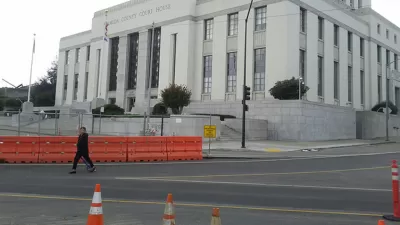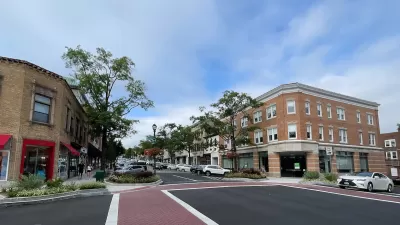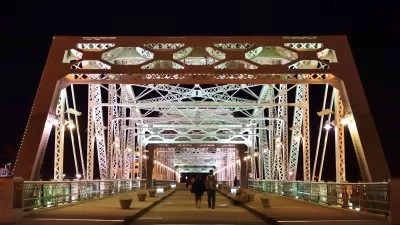"Every reasonable effort should be made to avoid and minimize construction impacts on pedestrian, bicycle, and bus facilities in Oakland," according to a guidance released by the city of Oakland earlier in 2017.

Liz Brisson recently examined the state of pedestrian accommodations around construction sites in the city. The subject is especially pertinent as the city continues a period of booming construction and investment, and in light of a guidance issued by OakDOT earlier this year [pdf] "to require designing for pedestrian convenience (as well for bicyclists and bus facilities) when buildings are under construction."
"When a construction sponsor files for an 'Obstruction Permit' to block sidewalk or street space, they must submit a 'Temporary Traffic Control Plan' (TTCP) that OakDOT staff review for compliance with the guidance before the permit is issued," explains the post of the administrative process involved in the new guidance.
That guidance also sets several standards: "'Pedestrian Detours' are not acceptable in Downtown Oakland, along major transit corridors, or along neighborhood commercial streets," and in other cases "Pedestrian Diversions" must be provided.
After explaining the intended purpose and process laid out by the new guidance, the post takes a short tour of several construction sites to examine how the new guidance is working so far. In several cases, construction sites were not yet complying with the guidance.
FULL STORY: Enforcing Safe Pedestrian Access During Oakland’s Construction Boom

Planetizen Federal Action Tracker
A weekly monitor of how Trump’s orders and actions are impacting planners and planning in America.

San Francisco's School District Spent $105M To Build Affordable Housing for Teachers — And That's Just the Beginning
SFUSD joins a growing list of school districts using their land holdings to address housing affordability challenges faced by their own employees.

The Tiny, Adorable $7,000 Car Turning Japan Onto EVs
The single seat Mibot charges from a regular plug as quickly as an iPad, and is about half the price of an average EV.

Seattle's Plan for Adopting Driverless Cars
Equity, safety, accessibility and affordability are front of mind as the city prepares for robotaxis and other autonomous vehicles.

As Trump Phases Out FEMA, Is It Time to Flee the Floodplains?
With less federal funding available for disaster relief efforts, the need to relocate at-risk communities is more urgent than ever.

With Protected Lanes, 460% More People Commute by Bike
For those needing more ammo, more data proving what we already knew is here.
Urban Design for Planners 1: Software Tools
This six-course series explores essential urban design concepts using open source software and equips planners with the tools they need to participate fully in the urban design process.
Planning for Universal Design
Learn the tools for implementing Universal Design in planning regulations.
Smith Gee Studio
City of Charlotte
City of Camden Redevelopment Agency
City of Astoria
Transportation Research & Education Center (TREC) at Portland State University
US High Speed Rail Association
City of Camden Redevelopment Agency
Municipality of Princeton (NJ)





























